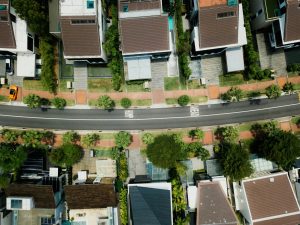Table of Contents
- Introduction to Sustainable Living in Modern Residences
- Incorporating Renewable Energy in Homes
- Sustainable Materials and Construction Techniques
- Waste Management and Recycling at Home
- The Economic Benefits of Living in an Eco-Friendly Home
- Integrating Smart Technology for Enhanced Energy Efficiency
- Community and Urban Planning for Sustainability
- Future Trends in Eco-Friendly Residential Spaces
- Closing Thoughts on Sustainable Home Life
Key Takeaways
- Incorporating sustainability can transform living spaces into eco-friendly havens.
- Renewable energy systems and intelligent technologies are instrumental in modern sustainable homes.
- Sustainable practices contribute significantly to the conservation of resources and the overall well-being of the planet.
Introduction to Sustainable Living in Modern Residences
As the world tackles climate change, adopting sustainable living is crucial. People seek eco-friendly apartments for rent that meet their needs. Sustainable living is a holistic approach covering how homes are built, resource consumption, and environmental harmony. Today’s eco-conscious residents focus on green living benefits from healthier indoor environments to financial savings. Builders and architects design sustainable residences that reduce reliance on non-renewable resources, promote better waste management, and provide an eco-friendly lifestyle. Making conscious choices about our spaces is necessary for a more sustainable future.
Incorporating Renewable Energy in Homes
Renewable energy sources are essential for eco-friendly homes. Technologies like solar panels, wind turbines, and geothermal systems offer energy efficiency and reduced carbon footprint. Case studies of communities using renewable energy demonstrate the practicality and benefits of these systems for residential use. By harnessing the powers of nature, we can provide clean, renewable, and cost-effective energy solutions for our homes and communities.
Sustainable Materials and Construction Techniques
Eco-friendly homes are made possible by choosing sustainable materials like bamboo, reclaimed wood, and recycled steel. These materials are often locally sourced and require less energy to produce. Construction methods have also evolved, incorporating practices like prefabrication to reduce material waste and improve efficiency. Choosing Energy Efficient Doors is also an efficient long-term solution to be more eco-friendly as you’ll use a lot less energy to keep the house warm. Since most energy comes from non-renewable sources, using as little as possible is the best way to help. Innovative techniques like passive solar design and green roofs make homes more energy-efficient, comfortable, and sustainable.
Waste Management and Recycling at Home
Effective waste management is crucial due to pollution and resource depletion. The three pillars – reduce, reuse, and recycle – reduce environmental impact. Composting kitchen scraps enriches soil, reducing the need for chemical fertilizers—measures like composting, reducing plastics, and using biodegradable alternatives help. With localized recycling efforts, consumption habits contribute to a sustainable flow of resources.For larger clean-up projects or bulk waste disposal, knowing where to find a dumpster hire company in your area is a practical step. Try an online search for ‘where can you rent a dumpster near you?‘ to find s service local to you. This provides a solid foundation for environmental stewardship.
Another durable, low-impact option gaining attention is contemporary log construction that integrates modern performance upgrades. Builders increasingly blend traditional log aesthetics with engineered framing and improved insulation to reduce thermal bridging and enhance airtightness—an approach often described as hybrid log homes. These hybrid systems pair well with passive-solar orientation and prefabrication methods, lowering on-site waste and shortening assembly times. For those who want natural materials without compromising year-round comfort, this offers a thoughtful balance of character and efficiency.
The Economic Benefits of Living in an Eco-Friendly Home
Sustainable living involves ecological and economic considerations. Energy-efficient appliances, insulation, and renewable energy installations save on utility bills over time. Although initial costs are high, long-term financial benefits and higher property values make it a worthwhile investment. Eco-friendly living provides both financial and environmental reasons to adopt green practices.
Integrating Smart Technology for Enhanced Energy Efficiency
Smart home tech maximizes energy efficiency. Smart thermostats learn household patterns and adjust heating/cooling for savings. LED lighting with intelligent switches/dimmers reduces power consumption. Advanced sensors detect occupancy and adjust systems in real time. Benefits include increased comfort, reduced energy use, and a contribution to sustainability. So, for homeowners seeking greater efficiency and convenience, working with a reliable team of Boston-based smart home specialists (or elsewhere) can offer tailored automation solutions that can optimize energy usage, integrate advanced sensors for real-time adjustments, and enhance overall comfort while helping reduce utility costs and environmental impact.
Community and Urban Planning for Sustainability
Sustainability goes beyond individuals to communities and urban planners. Communal gardens, shared transportation, and green spaces encourage eco-consciousness. Walkability and environmental urban planning lead to reduced carbon footprint, urban sprawl, and improved air quality. Working together, we can create sustainable communities.
Future Trends in Eco-Friendly Residential Spaces
As technology advances, new opportunities for sustainable residential design are emerging. Biophilic design enhances the connection between nature and the built environment, promoting well-being and environmental integration. Innovations like 3D-printed building components minimize waste and reduce the carbon footprint of building processes. Intelligent grids, storage batteries, and advancements in insulation materials are all part of the future landscape of eco-friendly living. These trends suggest that future homes will be more attuned to environmental needs while providing high-tech comforts.
Closing Thoughts on Sustainable Home Life
Our daily choices play a crucial role in the health of our planet. Sustainable living is a way to invest in our future, conserve resources, and create nurturing environments. As we innovate, sustainable living becomes more accessible, allowing us to balance our needs with the planet’s needs.








